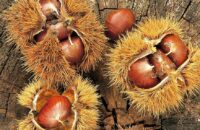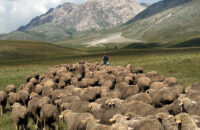The long night of St. John the Baptist arrives just after the Summer Solstice and, as it passes through towns, villages and districts ofAbruzzo, it brings to light its rich peasant tradition connected to the symbolism of water and fire.
Ancient rites to propitiate the beginning of the harvest season, celebrate the zenith and the slow descent of the sun. While partly rejected by Christian tradition as witchcraft, many of these rites have instead merged into the cult of the saint and culminate on the night of June 23-24.
A sacred night shrouded in mystery, a night of prodigies and purification where the waters of the sea, rivers, dew and even those from the plumbing at home were attributed by popular belief with legendary beneficial and almost magical properties to cure and soothe headaches, rheumatism and especially skin diseases.
As reported by Elvira Di Fulvio, in Fara Filiorum Petri the local elders remember that chi tenéve nu sfoche, that is, people suffering from any skin disease, used to go to the nearest river or spring on June 24 before dawn, to heal themselves they would light a small fire, throw the still burning tizzi into the stream and then wash themselves with the water while chanting the litany:
“St. Juvánne
Je m’allàve ‘n this currende water
And you aremmùreme stu foche ardenne”
But throughout Abruzzo there are several and numerous events as well as traditions and customs expected for this magical night.
CIVITELLA ROVETO – In Civitella Roveto, where the last strip of the province of L’Aquila forms the border between Marsica and Lazio, on the night of June 23-24 there is the custom of lighting bonfires and bathing at first light in the Liri River where the rite of “comparanza“ takes place: boys and girls crossing their pinkies in the name of St. John the Baptist forge an indissoluble bond of kinship.
COLLELONGO – Still keeping our eyes on Marsica, one of the most original customs is renewed every year in Collelongo: it is the “Nave di San Giovanni.” The ritual is done at home where one has to get a glass vessel and fill it with water. Then broken an egg and separated the yolk, only the albumen must be poured into the container, which immediately after must be placed outside the window, for the whole night in the moonlight. At dawn the prodigy that happens only on this very special night and that smacks of a good omen for the family has taken place: the concoction has taken shape and, looking at it closely, the water submerges guarding it an ancient ship with spars, sàrtie, tops and sails of all sizes.
And while from up there the lunar influence busies itself on the white of the egg to shape a sailboat, above the pavement of the alleys the hunt is already underway. Boys wander swiftly and silently to discover and steal the most beautiful roses to offer as a pledge to the sweetheart or the hope that the girl will become one.
The contented face of the one who finds colorful and fragrant roses the next morning is the exact opposite of that of the one who outside her door has received a cross made from an ungainly plant, stinking of garlic gone bad and even poisonous: the cicùta. In this case it is not so much dislike that plays a major role as a revenge for the “no” to revealed feelings. The size of the cross can be the most variable, perhaps depending on the size of the disappointment, but whether small or gigantic, it is best not to be discovered by the young recipient’s father.
INTRODACQUA – At Introdacqua in the Sulmonese province of L’Aquila, in addition to the preparation of St. John’s Water, the tradition of climbing Mount Plaja to watch the dawn break resists. A propitiatory rite of hope and renewal according to which young girls who reach the top of the mountain that morning and turn toward the east can see the beheaded head of the Baptist on the solar disk. Whichever of them glimpses it first will be married within the year. A founding moment for the community, beautifully described by Gabriele d’Annunzio in the tragedy La Figlia di Iorio when he has Ornella say, ” And tomorrow is Saint John, dear brother; it is Saint John. On la Plaia me vo’ ne vo’ gire, To see the severed head within the Sun, at the appearing, To see in the golden plate all the blood boil “.
LANCIANO, FOSSACESIA – In the Chietino area, on the night of St. John’s Day, girls would go on pilgrimage from Lanciano to Fossacesia and, before the sun came out, they would let down their hair to soak it in the sea water that makes it long, thick and beautiful. Still near Fossacesia is theAbbey of San Giovanni in Venere built on an ancient temple overlooking the sea and dedicated to the goddess. From here one can contemplate the sun “washing into the sea” as the head of St. John the Baptist plunges into a golden basin. If the sun’s face is clear, it is an indication of good luck; if it is seen gloomy, it is an indication of bad luck.
TORREVECCHIA TEATINA, MONTESILVANO COLLE, COLLEDIMEZZO – In Torrevecchia Teatina in the province of Chieti and in Montesilvano Colle in the province of Pescara, the Feast of the Flower Compari is revived with the collection of “lu ramajette” to give as a gift to the mate or comare. In Colledimezzo, also in the Chieti area, the appointment is with the harvesting of magical herbs and the preparation of St. John’s water.
ROME – With respect to the fascination of the encounter between the profane and the sacred, Rome has always been its mother and crossroads. In popular Roman tradition, St. John’s Night is also known as “Witches’ Night.” Superstition has it that during this night witches gather in Rome in front of the Basilica of St. John Lateran, invoking the names of Salome and Herodias who asked Herod for the head of the Baptist as a gift.
Even in the early twentieth century, the people of Rome flocked from all districts in front of the Basilica, with flashlights and lanterns (the fires of St. John), to pray to the saint, and during the festivities among other dishes in the taverns one could eat snails with sauce cooked in a large pot. To keep witches from entering the house, a broom and a jar of salt were hung outside the doorway, or two brooms crossed with heads of garlic. The festival ended at dawn with the firing of the cannon from Castel Sant’Angelo marking the beginning of the mass celebrated by the Pope at the Basilica of St. John, at the end of which he threw silver coins to the people from the loggia.
In the capital city, the historic “Night of the Witches” returns again this year for the Feast of St. John at the Gardens on Via Sannio with a full schedule of cultural, spectacular and workshop events aimed at all age groups to rediscover Roman tradition.
And yet for all those curious Romans or fans of the rituals associated with the night of St. John the Baptist, Abruzzo is there, just a stone’s throw away. Even easier: from St. John’s Square, Abruzzo is only an hour away by highway.
Read more: https://www.abruzzoturismo.it/







